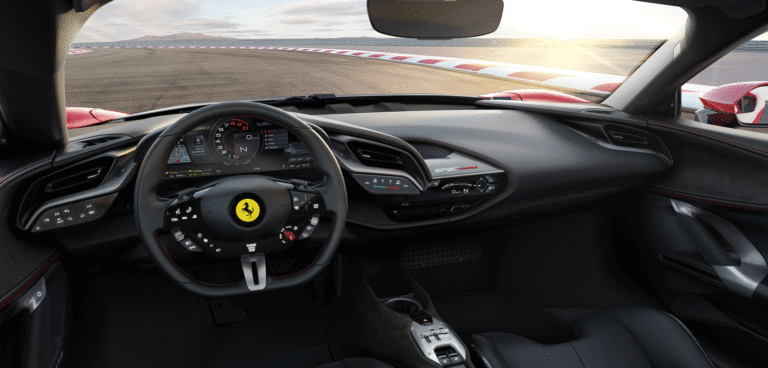Ferrari has detailed its first series production plug-in hybrid electric vehicle, the SF90 Stradale. Equipped with a reworked biturbo V8 and three electric motors, the SF90 will develop 1,000ps and 800Nm of torque at 6,000rpm.
The PHEV architecture sees the internal combustion engine integrated with three electric motors, two of which are independent and located on the front axle, with the third at the rear between the engine and the gearbox.
For the ICE, the starting point was the F154-family engine. However, Ferrari’s engineers focused on several different areas of the engine, starting by increasing its capacity from 3,902cc to 3,990cc thanks to a larger bore of 88mm.
The intake and exhaust system was completely redesigned and now features a new, narrower cylinder head with a central injector and the adoption of 350-bar GDI.
To improve the internal fluid dynamics, not only was a larger diameter intake valve adopted, but the ducts were horizontally lined up at engine head height; the OEM also lowered the turbo charger assembly and made the exhaust line higher.
In addition, the turbos were equipped with electronically controlled wastegates to improve catalyzer heating, while new compressor pumps were added to further improve fluid-dynamics.
The re-engineering goes beyond fluid-dynamics: the reworking of the layout has resulted in both a lower center of gravity, thanks in part to the adoption of a smaller-diameter fly wheel, and a reduction in overall weight thanks to the use of inconel instead of steel for the exhaust manifold.
The SF90 Stradale’s three electric motors are capable of generating a total of 220ps. A high-performance Li-ion battery provides power to all three motors and guarantees a 25km (15 mile) range in all-electric mode, using just the front axle.
The hybrid drive is paired to a redesigned 8-speed, oil-bath, dual-clutch transmission. New gear ratios and improved transmission efficiency yield a significant reduction in fuel consumption in urban and highway driving.
An optimized layout, achieved through the adoption of a dry sump and a significantly more compact clutch assembly with a 20% smaller exterior diameter than the current gearbox, shaved 15mm off the installed height in the car which, in turn, lowers the center of gravity of the running gear.
Despite the addition of an eighth gear, the gearbox is 10kg (22 lb) lighter. This is helped in part by the elimination of the reverse gear. The new clutch’s performance is 35% higher, transmitting up to 1,200Nm in dynamic torque in gear shifts.
Thanks to new-generation actuation hydraulics, total clutch fill times have been cut to 200ms compared with the 488 Pista’s 300ms.


